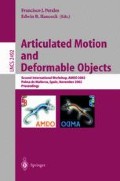Abstract
Animation and Realistic Simulation of a 3D object’s elastic deformation is actually an important and challenging feature in applications where three-dimensional object interaction and behaviour is considered or explored. Also, in interactive environments we need a rapid computation of deformations. In this paper we present a prototype of a system for the animation and simulation of elastic objects in an interactive system and under real-time conditions. The approach makes use of the finite elements method (F.E.M) and Elasticity Theory. The simulation is interactively visualized in an Open Inventor environment. Using picking node selection the user can interactively apply forces to objects causing their deformation. The deformations computed with our approach have a physical interpretation based on the mathematical model defined. Furthermore, our algorithms perform with either 2D or 3D problems. Finally, a set of results are presented which demonstrate performance of the proposed system. All programs are written in C++ using POO, VRML and Open Invertor tools. Real time videos can be visualized on web site: http://dmi.uib.es/people/mascport/defweb/dd.html
This work is partially subsidized by CICYT under grant TIC2001-0931 and by UE under grant Humodan-IST.
Access this chapter
Tax calculation will be finalised at checkout
Purchases are for personal use only
Preview
Unable to display preview. Download preview PDF.
References
Anshelevich, E., Owens, S., Lamiraux, F., Kavraki, L. E. Deformable Volumesin Path Planning Applications. ICRA 2000, Department of Computer Science, Rice University, Houston, 2000.
Aono, M. A. Wrinkle Propagation Model for Cloth. Proc. CG. Int’l, Springer-Verlag, 95–115, 1990.
Bro-Nielsen. M. Modelling Elasticity in Solids using Active Cubes-Application to Simulated Operations. Institute of Mathematical Modelling Technical University of Dennmark. 1994.
Ciarlet, P.G.. The Finite Element Method for Elliptic Problems. Université Pierre et Marie Curie, París. North-Holland Publishing Company, Amsterdam-New York, Oxford. 1980.
Cohen, L. D., Cohen, I. Finite Element Methods for Active Contour Models and Ballons for 2D and 3D Images. CEREMADE, France. Cahiers de Mathématiques de la Decisión, MD n∮ 9124 November 1991.
Debunne, G., Desbrun, M., Barr, A., Cani, M. P. Interactive multiresolution animation of deformable models. Computer Animation and Simulation’ 99. Eurographics Workshop, Milan, 1999.
Decaudin, P. Geometric Deformation by Merging a 3D-Object with a Simple Shape. INRIA. Graphics Interface’96 proceedings, Toronto. 1996.
Erdan, G., Duaquing, X., Jingbin, W., Chen, C. Dynamic Cloth Motion Simulation Using a Novel Fast Collision Detection. Computer Science and Engineering Department, ZheJiang Univ. Conference Paper, 2001.
Faloutsos, P. and M. van de Panne. And Demetri Terzopoulos. IEEE Transaction on Visualization and Computer Graphics, vol 3, n. 3, 1997.
Fang, S. and Raghavan, R. and Richtsmeier, T. Volume Morphing Methods for Landmark Based 3D Image Deformation. National University of Singapore,-School of Medicine, Baltimore, 1994.
Farin, G. Curves and surfaces for computer-aided geometric design: a practical guide. San Diego, California. London: Academic Press, ISBN: 0122490541, 1997
Fenster, D., Kender, J.R. Sectored Snakes: Evaluating Learned-Energy Segmentations. Department of Computer Science, Columbia University, New York, NY 1027 USA, 1998.
Gibson, S.F.F. and Mirtch, B. A Survey of Deformable Modelling in Computer Graphics. Technical Report, Mitsubishi Electrical Research, 1997.
Hagenlocke, M., Fujimura, K. CFFD: a tool for designing flexible shapes. The Visual Computer (1998) 14:271–287, Springer-Verlag 1998.
Hing, N. Ng and Grimsdale, R. L. Computer Graphics Techniques for Modelling Cloth. IEEE Computer Graphics and Applications, 28–41, 1996.
Kavraki, L.E., Lamiraux, F., Holleman, C. Towards Planning for Ellastic Objects. Department of Computer Science, Rice University (Huston). Workshop of Algorithmic Foundations of Robotics, pages 313–325, 1998.
Mascaró, M., Mir, A., Perales, F. Elastic Deformations Using Finite Element Methods in Computer Graphic Applications. AMDO 2000, pp. 38–47, 2000. Springer-Verlag Berlin Heidelberg 2000.
McInerney, T., Terzopoulos, D. Dept. of Computer Science, University of Toronto, Canada. Published in the Proc. CVRMed’97, Grenoble, France, march, 1997.
McDonnell, K.T., Quin, H., Wlodarczyk, R.A.. Dept. of Computer Science, University of New York at Stony Brook.
Metaxas, D. N. Physics-Based Deformable Models. University of Pensylvania, USA. KluwerAcademic Publishers, 1997.
Montagnat, J., Delingette, H., Scapel, N., Ayache, N. Representation, shape, topology and evolution of deformable surfaces. Application to 3D medical image segmentation. INRIA, 2000.
I. Nikitin, L. Nikitina, P. Frolov. Real Time simulation of elastic objetcs in Vitual Environments usign finite element method and precomputed Green’s functions. Eight EG Workshop on VE, 2002, 47–52, S. Muller, W. Sturzlinger (editors), 2002.
Nürnberger, A., Radetzky, A., Kruse R. Using recurrent neuro-fuzzy techniques for the identification and simulation of dynamic systems. Neurocomputing 36, 123–147, Elsevier Science B. V., 2001.
Raviart, P. A., Thomas, J. M. Introduction à l’analyse numérique des equations aux dérivées partielles. Ed. Masson, 3a edición, 1992.
Rudomin, I.J. Simulating Cloth using a Mixed Geometry-Phisycal Method. Doctoral Dissertation, Dept. of Computer and Information Science, Univ. Of Pennsylvania, 1990.
Shi-Min, H., Hui, Z., Chiew-Lang, T., Jia-Guang, S. Direct manipulation of FFD: efficient explicit solutions and decomposible multiple point constraints. The Visual Computer (2001) 17:370–379. Springer-Verlag 2001.
Terzopoulos, D., Qin, H. Dynamic NURBS with geometric constraints for interactive sculpting. ACM Transactions on Graphics, 13(3):103–136, 1994.
Thalmann, N. M., Carion, S., Courchesne, M., Volino, P., Wu, Y. Virtual Clothes, Hair and Skin for Beutiful Top Models. MIRAlab, University of Geneva, 1998.
Zabaras, N. Srikanth, A. An Object-Oriented Programming Approach to the Lagrangian FEM Analysis of Large Inelastic Deformations and Metal-Forming Processes. International Journal for Numerical Methods in Engineering. Int. J. Numer. Meth. Engng. 45, 399–445 (1999).
Author information
Authors and Affiliations
Editor information
Editors and Affiliations
Rights and permissions
Copyright information
© 2002 Springer-Verlag Berlin Heidelberg
About this paper
Cite this paper
Portells, M.M., Mir, A., Perales, F. (2002). P3DMA: A Physical 3D Deformable Modelling and Animation System. In: Perales, F.J., Hancock, E.R. (eds) Articulated Motion and Deformable Objects. AMDO 2002. Lecture Notes in Computer Science, vol 2492. Springer, Berlin, Heidelberg. https://doi.org/10.1007/3-540-36138-3_6
Download citation
DOI: https://doi.org/10.1007/3-540-36138-3_6
Published:
Publisher Name: Springer, Berlin, Heidelberg
Print ISBN: 978-3-540-00149-2
Online ISBN: 978-3-540-36138-1
eBook Packages: Springer Book Archive

